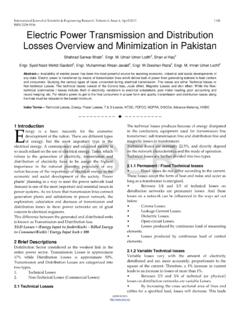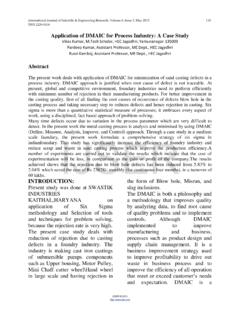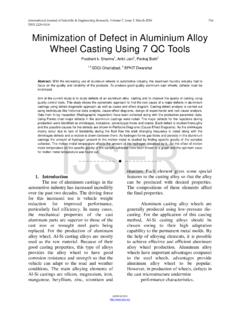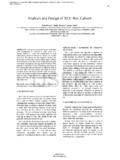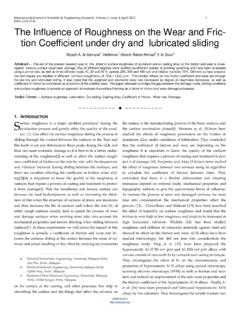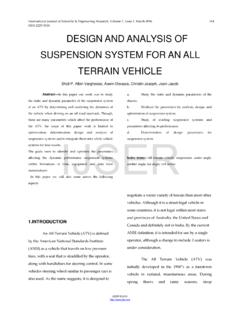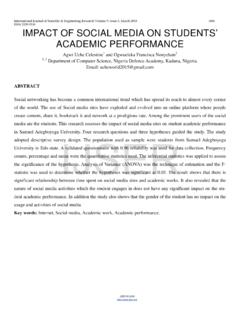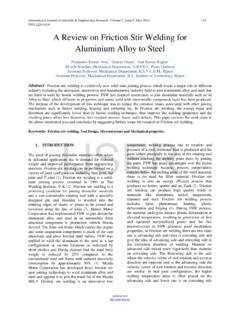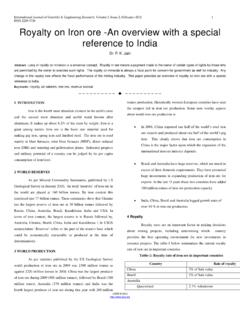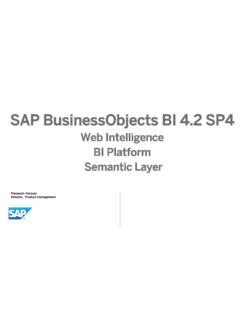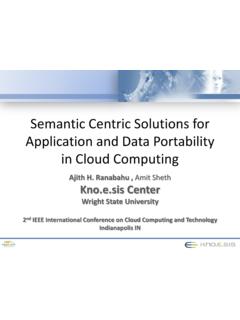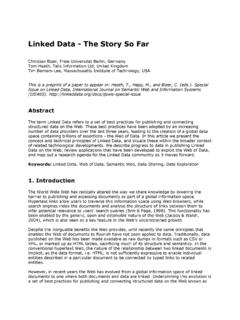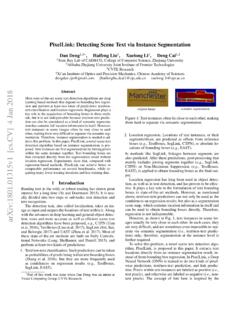Transcription of A Literature Review of E-Learning Model Based on …
1 International Journal of Scientific & Engineering Research, Volume 5, Issue 10, October-2014 174 ISSN 2229-5518 IJSER 2014 A Literature Review of E-Learning Model Based on Semantic Web Technology Mohit Srivastava, Himanshu Pandey, Sohit Shukla, Bhawesh Kumar Thakur Abstract-Research works in the field of E-Learning are represented by a broad spectrum of applications, ranged from virtual classrooms to remote courses or distance learning . W eb- Based courses offer obvious advantages for learners by making access to educational resource very fast, just-in-time and relevance, at any time or place.
2 In this paper, Based on our previous work, we present the Semantic W eb- Based Model for our E-Learning system. In addition we present an approach for developing a Semantic W eb- Based E-Learning system, which focus on the RDF data Model and OW L ontology language. Index Terms- E-Learning , Semantic W eb, RDF, Ontology, OW L. 1 INTRODUCTION E- learning is not just concerned with providing easy access to learning resources, anytime, anywhere, via a repository of learning resources, but is also concerned with s upporting such features as the personal definition of learning goals, and the synchronous and asynchronous communication, and collaboration, between learners and between learners and instructors.
3 One of the hottest topics in recent years in the AI community, as well as in the Internet community, is the Semantic Web. It is about making the Web more understandable by machines. It is also about building an appropriate infrastructure for intelligent agents to run around the Web performing complex actions for their users [1]. Furthermore, Semantic Web is about explicitly declaring the knowledge embedded in many web- Based applications, integrating information in an intelligent way, providing semantic- Based access to the Internet, and extracting information from texts [2]. Ultimately, Semantic Web is about how to implement reliable, large-scale interoperation of Web services, to make such services computer interpretable, , to create a Web of machine-understandable and interoperable services that intelligent agents can discover, execute, and compose automatically [3].
4 Unfortunately, the Web was built for human cons umption, not for machine consumption, although everything on the Web machine-readable, it is not machine-understandable [4]. We need the Semantic Web to express information in a precise, machine interpretable form, ready for software agents to process, share, and reuse it, as well as to understand what the terms describing the data mean. That would enable web- Based applications to interoperate both on the syntactic and semantic level. The premise underlying the concept of a learning object is that it can be reused. Current research and development efforts focus on establishing standard ways to annotate learning objects using metadata schemas so that they can be retrieved easily.
5 There is, however, a pressing need for research and development work to investigate how learning objects can be reused in a pedagogically appropriate way. This work-in- progress paper describes a project that aims to address this gap by developing a framework to assist teachers and instructional designers incorporate learning objects into generic learning designs they adapt to suit their educational contexts. We will introduce the implementation of Semantic Web concept on the E-Learning environment offered by our web- Based E-Learning system [5]. The facilities that the application will provide include allowing E-Learning content to be created, annotated, shared and discussed, together with supplying resources such as lecture notes, course description, documents, announcements, student papers, useful URL links, exercises and quizzes for evaluation of the student knowledge.
6 In its broadest sense, a learning object is any entity, digital or non-digital, that may be used for learning , education or training . This definition is useful in that it encompasses both content and activity- Based resources. However, it says little about the characteristics of learning objects that make them reusable. The paper is organized as follows: in Section (2) we present some related works. In section ( ) we give brief overview about the Semantic Web and discuss number of important issues. In section ( ) we introduce the Semantic Web Model for our web- Based E-Learning system, in section (3) we present the implementation of web Based E-Learning system.
7 In section (4) we present the system evaluation and the paper is finally concluded in section (5). 2 Literature SURVEY IJSERI nternational Journal of Scientific & Engineering Research, Volume 5, Issue 10, October-2014 175 ISSN 2229-5518 IJSER 2014 Several researchers studied the issue of Web Based application. F. P. Rokouet al. [6] distinguished three basic levels in every web- Based application: the Web character of the program, the pedagogical background, and the personalized management of the learning material. They defined a web- Based program as an information system that contains a Web server, a network, a communication protocol like HTTP, and a browser in which data supplied by users act on the system s status and cause changes.
8 The pedagogical background means the educational Model that is used in combination with pedagogical goals set by the instructor. The personalized management of the learning materials means the set of rules and mechanisms that are used to select learning materials Based on the student s characteristics, the educational objectives, the teaching Model , and the available media. Many works have combined and integrated these three factors in E-Learning systems, leading to several standardization projects. Some projects have focused on determining the standard architecture and format for learning environments, such as IEEE learning Technology Systems Architecture (LTSC), Instructional Management Systems (IMS), and Sharable Content Object Reference Model (SCORM).
9 IMS and SCORM define and deliver XML- Based interoperable specifications for exchanging and sequencing learning contents, , learning objects, among many heterogeneous E-Learning systems. They mainly focus on the standardization of learning and teaching methods as well as on the modeling of how the systems manage interoperating educational data relevant to the educational process [7].Juan Q uesada and Bernd Simon have also presented Model for educational activities and educational materials [8]. Their Model for educational activities denotes educational events that identify the instructor(s) involved and take place in a virtual meeting according to a specific schedule.
10 F. P. Rokouet al. [9] described the introduction of stereotypes to the pedagogical design of educational systems and appropriate modifications of the existing package diagrams of UML (Unified Modeling Language).The IMS and SCORM models describe well the educational activities and system implementation, but not the educational contents knowledge in educational activities. JuanQuemada s and F. s models add more pedagogical background by emphasizing educational contents and sequences using the taxonomy of learning resources and stereotypes of teaching models. But the educational contents and their sequencing in these models are dependent on the system and lack standardization and reusability.
